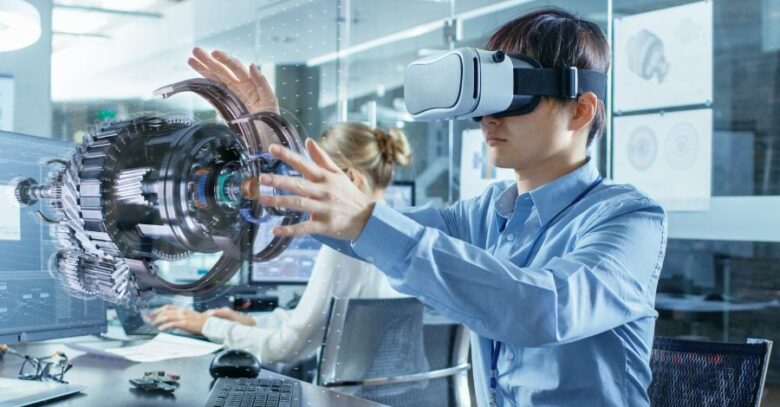The rapid evolution of digital technology has brought about many transformative tools, among which digital twins stand out as a compelling advancement. These virtual representations are revolutionizing various industries, from manufacturing to healthcare, delivering new depths of understanding and unprecedented insights. Beyond mere tools, they serve as sophisticated, live, and interactive reflections of their physical counterparts, contributing to process enhancements, improved efficiency, and the optimization of safety procedures.
In essence, digital twins form an integral part of the broader Industry 4.0 revolution. They epitomize the shift from conventional, often disjointed operational methodologies, towards a more interconnected, data-driven paradigm. This transformation, characterized by seamless integration and interaction between the physical and digital worlds, is creating myriad opportunities for industrial growth and safety improvements.
The upcoming sections delve deeper into the concept of digital twins, examining their role in promoting safety in various industries. Through this exploration, we aim to highlight how these virtual replicas can contribute to real-world safety improvements, underscoring their role in the future of industry.
Understanding Digital Twins
In simple terms, a digital twin is a dynamic, virtual replica of a physical object, process, or system. However, the concept is far more complex and extensive than this definition suggests. Digital twins encompass real-time data, machine learning algorithms, and advanced simulations to mirror the state and behavior of their physical counterparts accurately.
The creation of a digital twin involves an intricate process of data collection, modeling, and constant synchronization. Data is gathered from various sensors attached to the physical asset and is used to build a precise and dynamic digital model. This model, or twin, evolves concurrently with its real-world counterpart, reflecting any changes in state or operation. This real-time and interactive nature is what sets digital twins apart from traditional static simulations.
The true power of digital twins lies in their ability to simulate, predict, and optimize. They can recreate different scenarios, predict outcomes based on the data, and provide insightful recommendations for optimization. This capability makes them a valuable asset in multiple industries, particularly in enhancing safety measures.
Digital Twins and Safety Improvements
Digital twins have a significant role to play in the improvement of safety in various industries. By offering a detailed, real-time overview of operations, they allow for advanced monitoring and proactive mitigation of potential hazards. This can lead to the establishment of safer, more efficient work environments.
One way in which digital twins enhance safety is by enabling predictive maintenance. By continuously monitoring equipment condition, they can identify potential faults before they result in system failures. This early identification allows for timely maintenance, reducing the risk of accidents and improving overall safety.
Additionally, digital twins can improve safety by enabling more effective training of personnel. By creating a virtual replica of a workspace, for example, employees can interact with the model to learn about potential hazards and how to avoid them, without being exposed to actual risks. This hands-on, immersive training can lead to improved safety awareness and better adherence to safety protocols, further enhancing the overall safety of operations.
Predictive Maintenance and Safety
Digital twins play a pivotal role in predictive maintenance, enhancing safety measures in various industries. Through continuous real-time monitoring and data analysis, they can predict equipment failure before it happens, significantly reducing the risk of operational downtime and potential accidents. This predictive approach is in stark contrast to traditional reactive maintenance, which can often lead to unexpected breakdowns, causing safety hazards and productivity losses.
Moreover, predictive maintenance supported by digital twins can prevent unnecessary exposure of maintenance personnel to hazardous conditions. Instead of physically inspecting equipment in potentially dangerous environments, technicians can rely on data from the digital twin. This ensures that personnel only enter high-risk areas when necessary, thereby minimizing their exposure to potential risks.
Lastly, predictive maintenance through digital twins can contribute to longer equipment lifespan and better resource utilization. It enables timely and efficient maintenance activities, which can prevent severe damage and prolong the operational lifespan of equipment. As a result, safety is improved not only by preventing equipment failure but also by optimizing resource usage and minimizing waste.
Digital Twins in Process Safety
In the realm of process safety, digital twins have been instrumental in driving improvements. They allow for real-time monitoring and analysis of complex industrial processes, making it possible to identify potential safety issues before they escalate into serious problems. With the ability to simulate various scenarios, they offer valuable insights into the potential impact of different operational strategies on safety.
Furthermore, digital twins enable more precise and comprehensive risk assessments. They can model different risk scenarios and analyze their potential impact, considering various factors such as equipment condition, operational parameters, and environmental conditions. This capability allows organizations to develop more effective safety measures, mitigate risks proactively, and ensure compliance with safety regulations.
Additionally, digital twins can facilitate incident investigations. In the event of a safety incident, the digital twin can provide valuable data and insights into the conditions leading up to the incident. This can aid in identifying the root cause, prevent future occurrences, and enhance overall process safety.
Real World Applications of Digital Twins for Safety
Digital twins are already being used in various industries to improve safety. In the aerospace industry, for instance, digital twins of aircraft engines can monitor performance and predict maintenance needs, enhancing flight safety. Similarly, in the oil and gas industry, digital twins of drilling equipment can help prevent equipment failures that could lead to serious safety incidents.
In the manufacturing sector, digital twins of production lines can improve worker safety by predicting potential hazards and optimizing operational processes. Moreover, they can facilitate virtual training for workers, allowing them to familiarize themselves with safety procedures in a risk-free environment.
Finally, in construction, digital twins of building structures can assist in identifying structural weaknesses and potential safety issues during the design phase. They can also support safety planning during construction, such as identifying the safest sequences of construction activities, thus reducing the risk of accidents on the construction site. These real-world applications highlight the potential of digital twins to significantly improve safety across diverse industries.
Challenges of Implementing Digital Twins
While digital twins offer considerable potential for safety improvements, their implementation is not without challenges. One significant hurdle is the integration of digital twins with existing systems. The incorporation of digital twins into current infrastructure often requires substantial adjustments to ensure seamless data flow and system compatibility.
Moreover, creating an accurate digital twin demands comprehensive data, which can be a challenge given the varying quality, completeness, and consistency of data across different systems. The digital twin’s effectiveness greatly depends on the accuracy and granularity of the information fed into it. Consequently, inaccurate or incomplete data can lead to incorrect predictions, which may have serious safety implications.
Finally, privacy and security concerns are significant challenges associated with digital twins. Given the sensitive nature of the data involved, it is vital to have robust data security measures in place. Unauthorized access or data breaches could lead to significant safety and operational risks, making data security a key consideration in the implementation of digital twins.
The Future of Digital Twins in Safety Management
Digital twins are poised to become a game-changer in safety management. Their predictive capabilities, combined with real-time monitoring and detailed simulations, are set to redefine safety protocols across industries. As digital twins become more sophisticated, they may be able to predict complex safety scenarios, offering unprecedented foresight and safety planning capabilities.
The integration of artificial intelligence and machine learning with digital twins will likely further enhance their predictive abilities. This could enable even more precise predictions and simulations, allowing for the continuous improvement of safety measures.
Moreover, as augmented reality (AR) and virtual reality (VR) technologies continue to advance, their integration with digital twins could offer new possibilities for safety training. By providing immersive and realistic training experiences, these technologies could help personnel better understand safety procedures and potential risks in their working environment.
Conclusion
Digital twins represent a significant breakthrough in enhancing safety measures in various industrial sectors. Their ability to predict potential safety issues, conduct detailed risk assessments, and provide valuable insights during incident investigations makes them a vital tool for modern safety management. However, their implementation requires careful consideration of data quality, system integration, and data security.
The future of digital twins in safety management looks promising, with ongoing technological advancements set to further enhance their capabilities. While challenges remain, the potential benefits of digital twins for improving safety are immense, making them an essential component of future safety strategies. As we navigate the era of digital transformation, embracing technologies like digital twins will be key to achieving new levels of safety performance.




